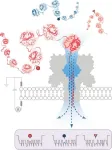(Press-News.org)
Scientists have developed a breakthrough method to detect structural variations on proteins based on nanopore technologies.
Protein chains are fed through an engineered nanopore, with subtle variations in structure detected through the modulation of tiny electrical currents.
The method could transform our understanding of how protein variants are associated with diseases, and allow point-of-care diagnostics.
A team of scientists led by the University of Oxford have achieved a significant breakthrough in detecting modifications on protein structures. The method, published in Nature Nanotechnology, employs innovative nanopore technology to identify structural variations at the single-molecule level, even deep within long protein chains.
Human cells contain approximately 20,000 protein-encoding genes. However, the actual number of proteins observed in cells is far greater, with over 1,000,000 different structures known. These variants are generated through a process known as post-translational modification (PTM), which occurs after a protein has been transcribed from DNA. PTM introduces structural changes such as the addition of chemical groups or carbohydrate chains to the individual amino acids that make up proteins. This results in hundreds of possible variations for the same protein chain.
These variants play pivotal roles in biology, by enabling precise regulation of complex biological processes within individual cells. Mapping this variation would uncover a wealth of valuable information that could revolutionise our understanding of cellular functions. But to date, the ability to produce comprehensive protein inventories has remained an elusive goal.
To overcome this, a team led by researchers at the University of Oxford’s Department of Chemistry has successfully developed a method for protein analysis based on nanopore DNA/RNA sequencing technology. In this approach, a directional flow of water captures and unfolds 3D proteins into linear chains that are fed through tiny pores, just wide enough for a single amino acid molecule to pass through. Structural variations are identified by measuring changes in an electrical current applied across the nanopore. Different molecules cause different disruptions in the current, giving them a unique signature.
The team successfully demonstrated the method’s effectiveness in detecting three different PTM modifications (phosphorylation, glutathionylation, and glycosylation) at the single-molecule level for protein chains over 1,200 residues long. These included modifications deep within the protein’s sequence. Importantly, the method does not require the use of labels, enzymes or additional reagents.
According to the research team, the new protein characterisation method could be readily integrated into existing portable nanopore sequencing devices to enable researchers to rapidly build protein inventories of single cells and tissues. This could facilitate point-of-care diagnostics, enabling the personalized detection of specific protein variants associated with diseases including cancer and neurodegenerative disorders.
Professor Yujia Qing (Department of Chemistry, University of Oxford), contributing author for the study, said: ‘This simple yet powerful method opens up numerous possibilities. Initially, it allows for the examination of individual proteins, such as those involved in specific diseases. In the longer term, the method holds the potential to create extended inventories of protein variants within cells, unlocking deeper insights into cellular processes and disease mechanisms.’
Professor Hagan Bayley (Department of Chemistry, University of Oxford), contributing author and co-founder of Oxford Nanopore Technologies, added: ‘The ability to pinpoint and identify post-translational modifications and other protein variations at the single-molecule level holds immense promise for advancing our understanding of cellular functions and molecular interactions. It may also open new avenues for personalised medicine, diagnostics, and therapeutic interventions.’
Oxford Nanopore Technologies, a spinout company launched in 2005 based on Professor Bayley’s research, has become established as a front-runner in next-generation sequencing technologies. Oxford Nanopore’s patented nanopore technology enables scientists to sequence nucleic acids (DNA and RNA) quickly using portable, inexpensive devices – in contrast to standard sequencing, which typically requires dedicated laboratories. Oxford Nanopore devices have revolutionised fundamental and clinical genomics and played a critical role during the COVID-19 pandemic in helping to track the spread of new coronavirus variants.
This work was carried out in collaboration with the research group of mechanobiologist Sergi Garcia-Maynes at King’s College London and the Francis Crick Institute.
Notes to editors:
The research findings have been published in the journal Nature Nanotechnology under the title, ‘Enzyme-less nanopore detection of post-translational modifications within long polypeptides’: https://www.nature.com/articles/s41565-023-01462-8
For media enquiries and interview requests, contact:
Professor Yujia Qing, Department of Chemistry, University of Oxford: yujia.qing@chem.ox.ac.uk +44 1865 272662
Professor Hagan Bayley, Department of Chemistry, University of Oxford: hagan.bayley@chem.ox.ac.uk
About the University of Oxford
Oxford University has been placed number 1 in the Times Higher Education World University Rankings for the seventh year running, and number 2 in the QS World Rankings 2022. At the heart of this success are the twin-pillars of our ground-breaking research and innovation and our distinctive educational offer.
Oxford is world-famous for research and teaching excellence and home to some of the most talented people from across the globe. Our work helps the lives of millions, solving real-world problems through a huge network of partnerships and collaborations. The breadth and interdisciplinary nature of our research alongside our personalised approach to teaching sparks imaginative and inventive insights and solutions.
Through its research commercialisation arm, Oxford University Innovation (OUI), Oxford is the highest university patent filer in the UK and is ranked first in the UK for university spinouts, having created more than 300 new companies since 1988. Over a third of these companies have been created in the past five years. Our Incubator at OUI supports the entrepreneurial ambition of University staff, students and alumni, and has created over 50 startups since 2011.
The university is working with partners in Oxford’s innovation ecosystem to harness exceptional science and technology and turn it into commercially successful businesses that drive societal impact, transform lives globally, and fuel economic growth. We are seeing success in engaging more investors and strategic partnerships, developing more space, attracting more talent, and creating more opportunities for entrepreneurs and their companies to scale. We are increasingly connected locally, nationally and globally.
For every £1 million invested in research at the University results in an additional economic output of £5.3 million across the UK economy. For each £1 million of its research income, the University’s research and knowledge exchange activities generated a total of £10.3 million in economic impact across the UK.
The university is a catalyst for prosperity in Oxfordshire and the United Kingdom, contributing £15.7 billion to the UK economy in 2018/19, and supports more than 28,000 full time jobs.
Find out more: https://innovation.ox.ac.uk/
END
Nanopore technology achieves breakthrough in protein variant detection
2023-08-01
ELSE PRESS RELEASES FROM THIS DATE:
Google & ChatGPT have mixed results in medical informatiom queries
2023-08-01
When you need accurate information about a serious illness, should you go to Google or ChatGPT?
An interdisciplinary study led by University of California, Riverside, computer scientists found that both internet information gathering services have strengths and weaknesses for people seeking information about Alzheimer's disease and other forms of dementia. The team included clinical scientists from the University of Alabama and Florida International University.
Google provides the most current information, but query results are skewed by service and product providers seeking customers, the researchers found. ChatGPT, meanwhile, ...
A novel laser slicing technique for diamond semiconductors
2023-08-01
Silicon-based materials are currently the undisputed leaders in the field of semiconductors. Even so, scientists around the world are actively trying to find superior alternatives for next-generation electronics and high-power systems. Interestingly, diamonds are among the most promising materials for applications such as fast telecommunications and power conversion in electric vehicles and power plants.
Despite their attractive properties for the semiconductor industry, the applications of diamonds are limited due to the lack of techniques to slice them into thin wafers efficiently. As a result, diamond wafers must be synthesized one by one, making fabrication ...
California’s winter waves may be increasing under climate change
2023-08-01
A new study from UC San Diego Scripps Institution of Oceanography researcher emeritus Peter Bromirski uses nearly a century of data to show that the average heights of winter waves along the California coast have increased as climate change has heated up the planet.
The study, published today in the Journal of Geophysical Research - Oceans, achieved its extraordinarily long time series by using seismic records dating back to 1931 to infer wave height, a unique but accepted method first developed by Bromirski in 1999. The results, made more robust by their ...
DNA decodes the dining preferences of the shell-shucking whitespotted eagle ray
2023-08-01
With mighty jaws and plate-like teeth, the whitespotted eagle ray (Aetobatus narinari) can pretty much crunch on anything. In fact, hard clam farmers in Florida’s Indian River Lagoon have considered this species a threat to their production efforts and profit margin. This assumption, however, is mostly anecdotal.
Despite their protected status in Florida and designation as globally “endangered,” there is limited information in the United States available on critical components of the life history of the whitespotted eagle ray, such as their diet. Prior observations have described a location-specific yet variable diet consisting of hard ...
GI symptoms persist in older female colorectal cancer survivors
2023-08-01
COLUMBUS, Ohio – More than 4 out of 5 older women survivors of colorectal cancer may be experiencing a range of gastrointestinal symptoms many years after being diagnosed and treated, a new study suggests.
Using data from the Women’s Health Initiative, researchers found that 81% of colorectal cancer survivors reported persistent GI symptoms, with abdominal bloating and gas topping the list as the most common and severe problem. The average time since diagnosis was eight years for all participants whose data was used in the study.
The analysis also showed that severe GI symptoms were linked to poor quality of life, ...
CHLA researcher to lead first-ever international liquid biopsy retinoblastoma study
2023-08-01
Just a handful of years ago, retinoblastoma had the medical field stumped. This pediatric eye cancer cannot be directly biopsied, which means clinicians must diagnose the disease by visual examination and imaging. Recently, a researcher at Children’s Hospital Los Angeles developed a new way to diagnose retinoblastoma by sampling the fluid at the front of the eye. These liquid biopsies also offer genetic and chromosomal information, which gives a more complete picture of each child’s disease. Now CHLA will lead an international liquid biopsy retinoblastoma study, the first of its kind.
A New Line of Research
Jesse Berry, MD, is the Director of Ocular Oncology ...
The cost of climate change: 2°C global warming target is not economically reasonable unless we make major changes
2023-08-01
Climate change goals set out in the Paris Agreement are only economically reasonable if non-market factors such as human health and loss of biodiversity are prioritised, according to a new study published by Dr Taikan Oki, former Senior Vice-Rector of United Nations University headquartered in Japan, in IOP Publishing’s academic journal Environmental Research Letters.
A multi-disciplinary, collaborative effort from researchers at 23 institutions including The University of Tokyo, National Institute for Environmental Studies, and Kyoto University, the new study provides a cost-benefit analysis ...
56 percent of Saudi Arabian women never had a cervical cancer screening test | BGI Insight
2023-08-01
Only 19% of Saudi Arabian women are diagnosed at stage I of cervical cancer where survival rates are highest, according to a study published by the King Abdulaziz University. To further motivate action to combat cervical cancer, BGI Genomics today released its State of Cervical Cancer Awareness Report in Saudi Arabia. This report assesses the level of knowledge, attitudes, and practices related to cervical cancer screening and HPV vaccination. By examining these key areas, this survey seeks to highlight the associated barriers and opportunities. 1,878 female respondents from six countries ...
E-cigarettes may be better than nicotine patches in helping pregnant women stop smoking and in reducing the risk of low birthweight
2023-08-01
Smoking in pregnancy can harm developing babies, especially their growth . Current guidelines recommend that pregnant smokers who find quitting difficult should be provided with nicotine replacements products and stop-smoking services usually recommend nicotine patches.
This research published in NIHR Journals Library, suggests that pregnant women should also consider e-cigarettes.
The study included 1,140 pregnant women who were trying to stop smoking who were divided into two groups. Half of the women received e-cigarettes; the other half received nicotine patches. Both approaches were equally safe. The only meaningful difference was that fewer ...
Researchers unveil new cipher system that protects computers against spy programs
2023-08-01
A group of international researchers has achieved a breakthrough in computer security with the development of a new and highly efficient cipher for cache randomization. The innovative cipher, designed by Assistant Professor Rei Ueno from the Research Institute of Electrical Communication at Tohoku University, addresses the threat of cache side-channel attacks, offering enhanced security and exceptional performance.
Cache side-channel attacks pose a significant threat to modern computer systems, as they can stealthily extract sensitive information, including secret keys and passwords, from unsuspecting victims. ...







